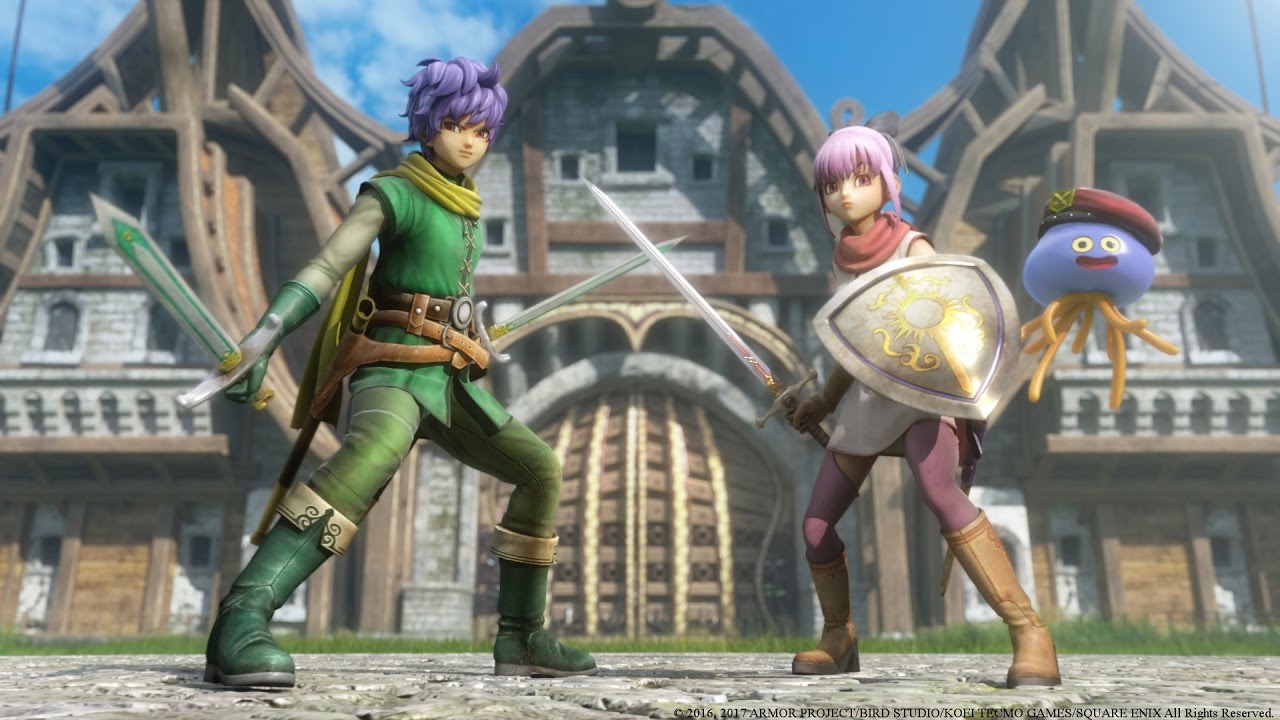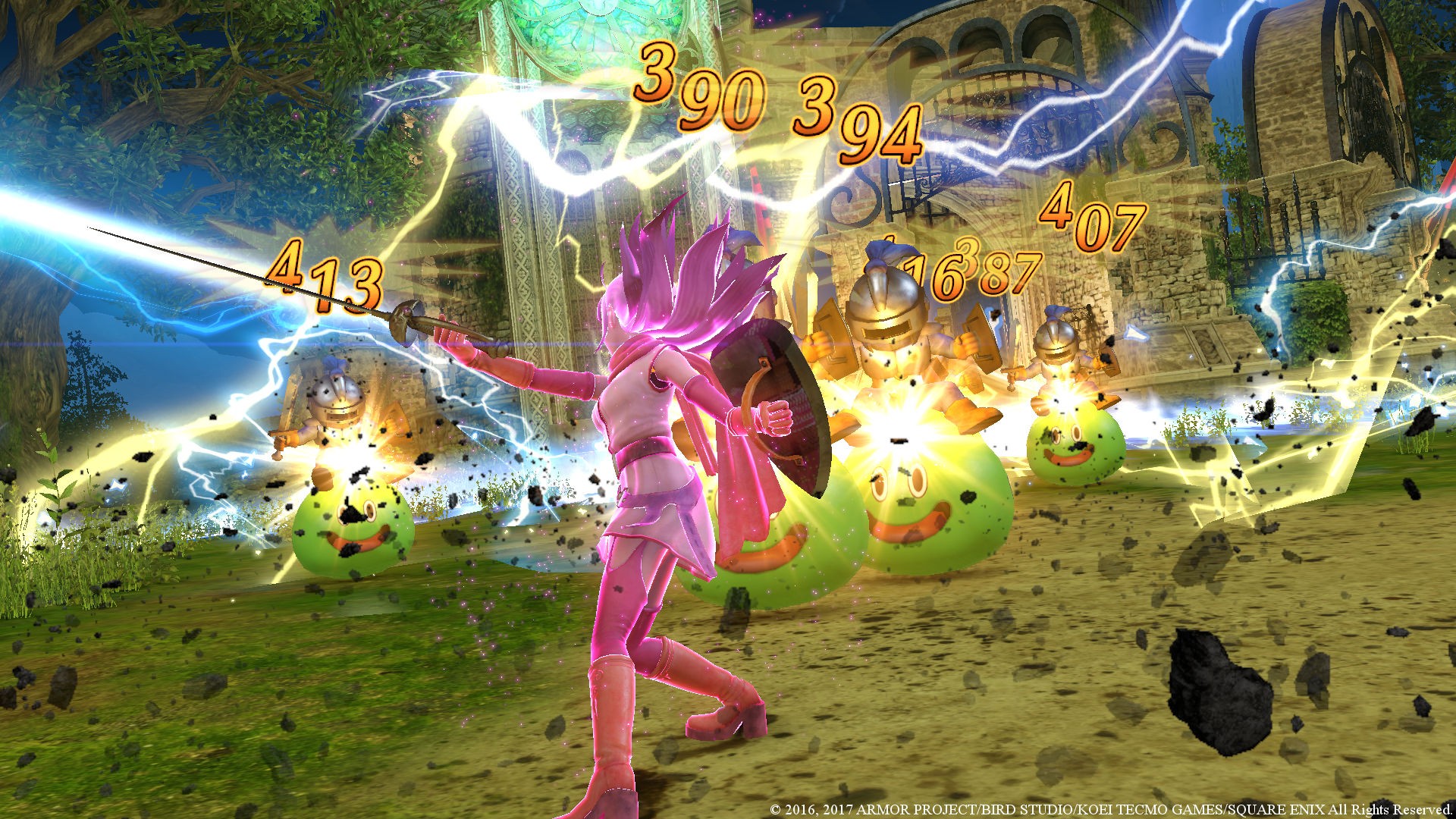Search
[{{{type}}}] {{{reason}}}
{{/data.error.root_cause}}{{{_source.title}}} {{#_source.showPrice}} {{{_source.displayPrice}}} {{/_source.showPrice}}
{{#_source.showLink}} {{/_source.showLink}} {{#_source.showDate}}{{{_source.displayDate}}}
{{/_source.showDate}}{{{_source.description}}}
{{#_source.additionalInfo}}{{#_source.additionalFields}} {{#title}} {{{label}}}: {{{title}}} {{/title}} {{/_source.additionalFields}}
{{/_source.additionalInfo}}- Details
- Category: Computer
- By Daniel Cullen
- Hits: 3797
Dragon Quest Heroes II (PC)

Dragon Quest Heroes II
Developed By: Omega Force
Published By: Square Enix
Released/Available On: PlayStation 3/PS Vita
Release date: April 25, 2017
Genre: Action role-playing/hack and slash
ESRB Rating: Teen for Fantasy Violence, Mild Blood, Mild Suggestive Themes
Number of Players: Single player, Online Multiplayer
Price: $59.99
(Amazon Affiliate Link)
Dragon Quest Heroes 2 is the sequel to the first game, with its own new story, utilizing an improved engine and gameplay. It still retains the mix of Dragon Quest aesthetics and Koei Temco hack-and-slash gameplay that made the first game so much fun.
The kingdoms of the realm were generally at peace with another, and while there were occasional conflicts, wars were an ancient memory, in part due to a prophecy that the lands would be brought to destruction once again if brother turned against brother. Said peace is then rent asunder as the realms are brought to war with another, with a mysterious fiend plotting to make them fight each other as they did in the days of old; that is unless you put a stop to their plans before they unseal an ancient evil in the process.
Like the first game, you can pick a male or female original character, either Teresa (female) or Lazarel (male), with the one you don’t choose as a secondary protagonist. This will also affect some story scenes as well. Initially, your characters hail from the Kingdom of Harba, but soon warriors from the other realms and those from other worlds in the Dragon Quest franchise will join forces in a coalition to restore peace to all the kingdoms, again, much like in the first Heroes.
As opposed to the rather black and white “good vs. evil” plot of the first game, this one opts for more complexity, involving political intrigue and a sinister force willing to start wars by treachery and deception. Monsters can be both ally and enemy, some willingly allied with humanity, some as enemies, and while the game largely avoids pitting humans against one another and tries to find as many excuses to make humans and monsters the only conflicts, suspension of disbelief is a bit strained at times. This quickly wears off as the plot is generally good at avoiding making this too implausible. There are some inevitable battles between human characters, but these usually tend to be of story related importance.
The change to an open world like format means levels are less static with more freeform objectives compared to the individual stage like maps of the first game. This leads to the story no longer having so many bizarre intermissions between levels that strain credibility like in the previous game, though they certainly try to structure the plot to give the player intermissions to upgrade equipment and change party members anyway.
This entry refines the Dragon Quest RPG mechanics mixed with Koei Temco hack and slash formula used since the first title and all the essentials that worked well then work well here. Due to the shift in play-style to using a semi-open world style, the game places greater emphasis on area warp spots and features a central map hub where you can retreat to in-between missions that can allow you to revisit any areas previously visited, as opposed to the world map where you chose certain stages to visit from an airship hub like in the first game. This is thought out well enough that aside from involving more walking around as a result (though the dash key makes this bearable), navigation remains easy.

Strong Points: Excellent refinement of Dragon Quest Heroes I mechanics; excellent storywriting
Weak Points: More tedious emphasis on fetch quests
Moral Warnings: Minor occult references; slightly more prominent sexualized costumes than the previous games
The monster medals you can collect from fallen monsters to later summon them as allies system remains largely unchanged from the last title, save for “Transformation” medals that let the player assume the form of certain monsters and use their attacks until the transformation timer ends. Again, like the last title, making good use of this system will be useful in later levels, but early areas provide plenty of time to get used to the said game mechanic.
The semi-open world style means certain areas are now filled with terrain hazards and certain parts of maps are blocked off until you attain a means of passing them that replaces the collectible maps from the previous game. As for the terrain hazards, these include lava and poison swamps and provide some maps interesting tactical challenges, especially when needing to defeat certain enemies that use this terrain defensively.
Quests return like in the last entry, the leveling system is largely the same aside from a new class mechanic that allows the primary characters to be developed much more extensively than in the first game, and certain passive talents become learn-able for the whole party that can provide bonuses in combat that further increase your options. The only discordant note is the item crafting system, which was streamlined since the last game, but the new mechanic of being able to continually upgrade the same accessory by collecting certain materials several times over can lead to more fetch quest tediousness compared to the first game, though it also allows the player to conserve resources like money more easily, so it has its good and bad points.
Graphically, the same colorful, cel-shaded style as the first game is reused, complete with anime-style aesthetics. There are some reused assets since there are some returning characters, but many areas are new. And, since the game uses a semi-open world format this time around, those with excellent graphics cards will be able to see quite far into the distance and see some beautifully rendered world settings. The orchestral sound style of the first game with retro style sound effects for menus as well as excellent voice work returns from the first title.
Much like the first game, it's recommended to play this with a PC controller of some sort, but unlike the first game, which had some occasional graphical crashes with Nvidia cards on Windows 8/10, this does not seem to be an issue for this game. Requirements for the game should be met to at least above the medium quality settings for optimal play, ideally should meet or exceed the recommended specifications since the game engine has been greatly refined in scope and quality. Otherwise, there may be some slowdown in frame rate, especially if all graphical settings are maxed out.
This game is still easier to play with a controller than with a keyboard and mouse like the first game. It’s worth noting some Quality of Life improvements were made since the last game, with some reworked menus and a dash button for traversing large areas as noted above.

Higher is better
(10/10 is perfect)
Game Score - 88%
Gameplay - 17/20
Graphics - 9/10
Sound - 9/10
Stability - 4/5
Controls - 5/5
Morality Score - 75%
Violence - 4.5/10
Language - 6.5/10
Sexual Content - 4/10
Occult/Supernatural - 8.5/10
Cultural/Moral/Ethical - 8.5/10
(+6 bonus points for showing consequences of evil and for good moral lessons)
In terms of morality, this is much like the first game in being no better or worse than the standard Dragon Quest, though it has some changes both morally good and bad. Violence remains largely bloodless and cartoon-like despite the generally darker tone, no bloodshed or gore like the last game. Language remains quite mild, with maybe some very mild expletives at worst (like "damned" in the religious sense), and a few enemies mention "Hell" in their naming schemes, but that's about it. Sexual Content is about the same as the last Heroes, where aside from some fanservicey costumes (a few midriffs are exposed and some of the same cleavage-baring outfits from the first game return), suggestive dialogue, and some crude humor, it generally is not more unsuitable than any product aimed at the average 13-15-year-old should be.
One of the playable characters is a fortuneteller who uses Tarot Cards, though this gets generally regarded as a fantasy element and no more plausible than the otherwise obviously unrealistic elements used to make this sort of high fantasy style setting work, and her powers of divination are directly attributed to the stand-in for God in the Christianity analog according to the lore. The story does feature an interesting Cain and Abel style backstory twist that gets some creative use, and elements of the story are reminiscent of said Biblical account of the two brothers in their depiction, but aside from some similarities, there is otherwise no direct Biblical parallels drawn and it’s used as part of the fantastical backdrop.
The in-universe religion is again the generic Christianity analog used in most Dragon Quest games, with a Goddess who serves as the Christian God stand in. The game contains a few more direct references to alcohol consumption and gambling than the previous game, but these remain background elements for the most part.
Like the last entry, moral lessons in trusting one’s friends are a prominent theme, and several characters who are obsessed with revenge for several different reasons are called out on doing so, with a consistent theme that it’s wrong and simply leads to pointless harm for no reason other than sheer spite. Another good theme is that leaders are called out for not putting their interests of their people first and that they need to be proper examples of morals for their subjects.
There is at least one instance where one must rebel against authority, but in that instance (without giving away spoilers), they have totally abandoned their responsibilities to their people and your rebellion is no worse than that of the Judges of the Bible book of the same name freeing the people from their tyranny, therefore such rebellion is firmly rooted in reaffirming that authority must be derived from responsible and lawful moral conduct, else it will be taken away by those who do uphold the laws and the morals they are meant to reinforce. In essence, like the previous title, aside from minor moral issues, it is no worse than the first Heroes had for the most part, and this is an excellent Dragon Quest-themed hack and slash game suitable for any reasonably mature teenager or older.








